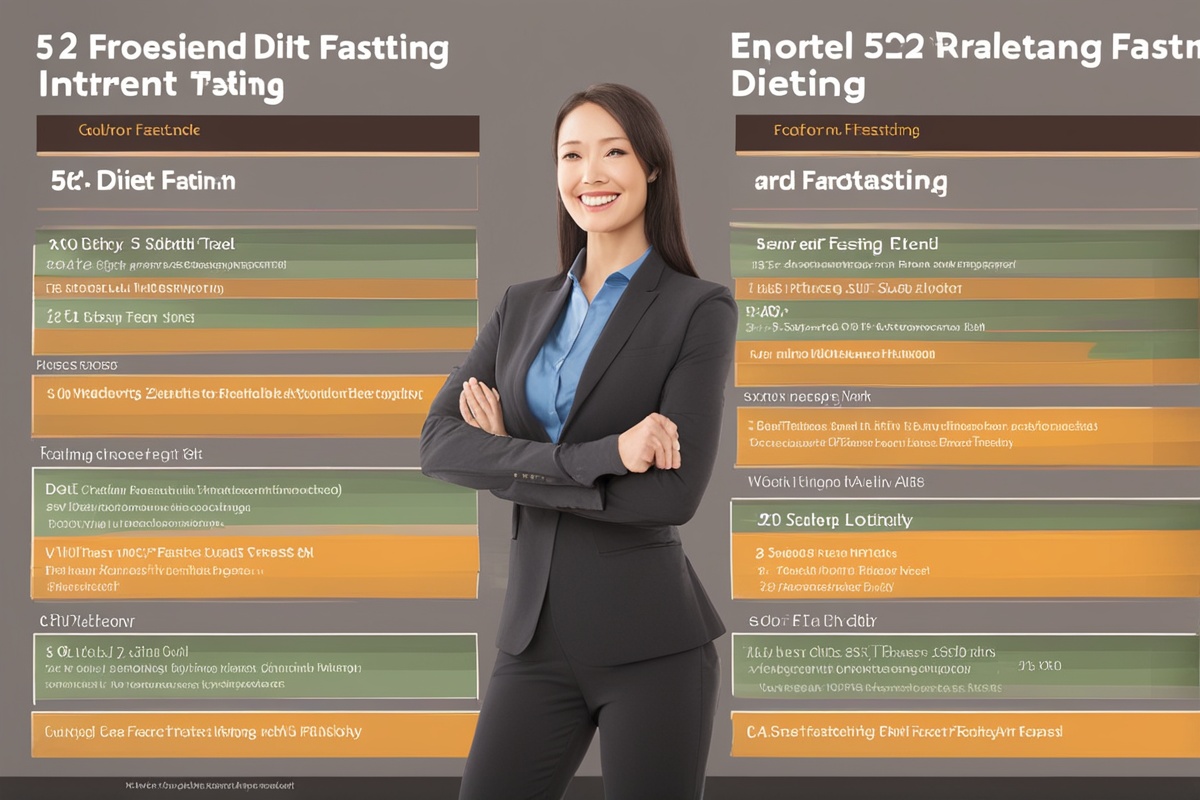Hey there, health enthusiasts! If you’ve been curious about intermittent fasting and are looking for actionable fasting tips to kickstart a sustainable weight loss journey, the 5:2 diet might just be your golden ticket. This popular fasting method, often dubbed the “part-time diet,” has taken the wellness world by storm for its simplicity and science-backed benefits. In this comprehensive guide, we’ll dive deep into what the 5:2 Diet entails, how it works, and why it’s more than just a fad. Whether you’re a newbie to fasting or a seasoned pro seeking fresh intermittent fasting advice, I’ve got you covered with practical strategies, scientific insights, and real-world tips to make this lifestyle stick. Let’s explore how the 5:2 Diet can transform your health—one fast at a time!
What Is the 5:2 Diet? A Beginner’s Overview
The 5:2 Diet, popularized by Dr. Michael Mosley in his book The Fast Diet, is a form of intermittent fasting that alternates between regular eating and calorie restriction. The premise is simple: for five days of the week, you eat normally, without obsessing over calories, and for the remaining two days, you limit your intake to about 500–600 calories. These “fasting days” don’t require complete abstinence from food, which makes this approach more approachable than other fasting regimens. The goal? To create a calorie deficit over the week while reaping the metabolic and cellular benefits of fasting. Studies suggest that this method can support weight loss and improve insulin sensitivity (Varady et al., 2013). If you’re searching for fasting tips for beginners, starting with the 5:2 Diet offers a flexible entry point into the world of intermittent fasting.
How Does the 5:2 Diet Work? The Science Behind It
At its core, the 5:2 Diet leverages the body’s response to calorie restriction and fasting. When you drastically cut calories on fasting days, your body shifts into a state of mild stress, triggering processes like autophagy—where cells clean out damaged components—and improved fat burning for energy (Mattson et al., 2017). This isn’t just about shedding pounds; research indicates that intermittent fasting can lower inflammation, enhance brain health, and even reduce the risk of chronic diseases like type 2 diabetes (Patterson et al., 2015). The beauty of the 5:2 approach lies in its balance—you’re not starving every day, which makes it psychologically easier to maintain. For those seeking effective fasting strategies, understanding these mechanisms can help you stay motivated, knowing your efforts are backed by science.
Benefits of the 5:2 Diet: Why Try It?
Beyond weight loss, the 5:2 Diet offers a range of health perks that make it a standout choice for many. Let’s break down some of the key reasons why this fasting style is worth considering, especially if you’re after healthy fasting practices that deliver results.
- Weight Loss and Fat Reduction: By creating a weekly calorie deficit, the 5:2 Diet helps you lose weight without the monotony of daily restrictions. Studies show it’s as effective as traditional diets for fat loss (Harvie et al., 2011).
- Improved Metabolic Health: Fasting days can enhance insulin sensitivity, helping to regulate blood sugar levels and reduce the risk of diabetes (Barnard et al., 2019).
- Heart Health Benefits: Research suggests that intermittent fasting may lower blood pressure and cholesterol levels, supporting cardiovascular wellness (Trepanowski et al., 2017).
- Mental Clarity and Energy: Many followers report feeling sharper and more focused on fasting days, likely due to the brain-boosting effects of ketosis (Mattson et al., 2017).
These benefits aren’t just anecdotal—they’re grounded in research, making the 5:2 Diet a compelling option for anyone looking to improve their health through fasting.
Practical Fasting Tips for Mastering the 5:2 Diet
Starting the 5:2 Diet can feel daunting, but with the right fasting tips and tricks, you’ll find your groove in no time. I’ve been experimenting with intermittent fasting for years, and trust me, a little preparation goes a long way. Here are some hands-on strategies to help you succeed, whether it’s your first fast or your fiftieth.
- Plan Your Fasting Days Wisely: Choose non-consecutive days for fasting (like Monday and Thursday) to avoid burnout. Align them with quieter days when you’re less likely to face social eating pressures.
- Stock Up on Low-Calorie, High-Volume Foods: On fasting days, opt for veggies, broth-based soups, and lean proteins to feel fuller longer. Think zucchini noodles or a hearty vegetable soup for just 100–200 calories.
- Stay Hydrated: Drink plenty of water, herbal teas, or black coffee to curb hunger pangs. Dehydration can mimic hunger, so keep a water bottle handy.
- Break Your Fast Thoughtfully: After a fasting day, avoid binging on heavy meals. Start with something light like a smoothie or salad to ease your digestive system back into action.
- Track Your Progress: Use a journal or app to log your meals, mood, and energy levels. This can help you tweak your approach and stay accountable to your fasting goals.
Remember, the 5:2 Diet isn’t about perfection—it’s about consistency. If a fasting day feels too tough, don’t beat yourself up. Adjust and keep going!
Potential Challenges and How to Overcome Them
Let’s be real: fasting isn’t always a walk in the park. While the 5:2 Diet is more flexible than other protocols, you might still hit some bumps along the way. Hunger, irritability, and social dining dilemmas are common hurdles. But with the right fasting tips for success, you can navigate these challenges like a pro. For instance, if hunger strikes on a fasting day, distract yourself with a low-effort activity like reading or a short walk. Feeling “hangry”? Sip on some electrolyte-rich broth to stabilize your mood. And if a dinner party falls on a fasting day, don’t stress—either swap your fasting day or stick to a small portion of low-calorie options. The key is to anticipate obstacles and have a game plan. After all, fasting should enhance your life, not control it.
Who Should Try the 5:2 Diet—and Who Shouldn’t?
While the 5:2 Diet offers incredible benefits, it’s not a one-size-fits-all solution. If you’re generally healthy, have a few pounds to lose, or want to boost metabolic health, this could be a fantastic fit. However, certain groups should steer clear or consult a healthcare provider first. Pregnant or breastfeeding women, individuals with a history of eating disorders, and those with medical conditions like diabetes or low blood pressure should avoid fasting without medical guidance (Harvie et al., 2011). If you’re unsure, chat with a doctor or dietitian before diving into any intermittent fasting plan. Safety always comes first, and tailoring the diet to your unique needs is the ultimate fasting tip for long-term success.
As we wrap up, I hope this deep dive into the 5:2 diet has given you a clear roadmap to harness the power of intermittent fasting. With the right fasting tips and a bit of patience, this approach can be a game-changer for your health and wellness goals. It’s not just about cutting calories—it’s about resetting your body, mind, and relationship with food. Start small, listen to your body, and don’t hesitate to tweak the plan to fit your lifestyle. Have you tried the 5:2 Diet before, or are you just getting started? Drop your thoughts or questions in the comments—I’d love to hear your story! Remember, fasting is a journey, not a race, and every step forward counts. Here’s to healthier, happier days ahead!
References
- Barnard, N. D., Levin, S. M., & Yokoyama, Y. (2019). A systematic review and meta-analysis of changes in body weight in clinical trials of vegetarian diets. Journal of the Academy of Nutrition and Dietetics, 119(5), 785-793. https://doi.org/10.1016/j.jand.2018.11.016
- Harvie, M. N., Pegington, M., Mattson, M. P., et al. (2011). The effects of intermittent or continuous energy restriction on weight loss and metabolic disease risk markers: A randomized trial in young overweight women. International Journal of Obesity, 35(5), 714-727. https://doi.org/10.1038/ijo.2010.171
- Mattson, M. P., Longo, V. D., & Harvie, M. (2017). Impact of intermittent fasting on health and disease processes. Ageing Research Reviews, 39, 46-58. https://doi.org/10.1016/j.arr.2016.10.005
- Patterson, R. E., Laughlin, G. A., LaCroix, A. Z., et al. (2015). Intermittent fasting and human metabolic health. Journal of the Academy of Nutrition and Dietetics, 115(8), 1203-1212. https://doi.org/10.1016/j.jand.2015.02.018
- Trepanowski, J. F., Kroeger, C. M., Barnosky, A., et al. (2017). Effect of alternate-day fasting on weight loss, weight maintenance, and cardioprotection among metabolically healthy obese adults: A randomized clinical trial. JAMA Internal Medicine, 177(7), 930-938. https://doi.org/10.1001/jamainternmed.2017.0936
- Varady, K. A., Bhutani, S., Klempel, M. C., et al. (2013). Alternate day fasting for weight loss in normal weight and overweight subjects: A randomized controlled trial. Nutrition Journal, 12, 146. https://doi.org/10.1186/1475-2891-12-146






